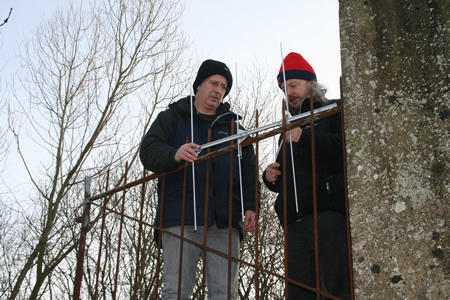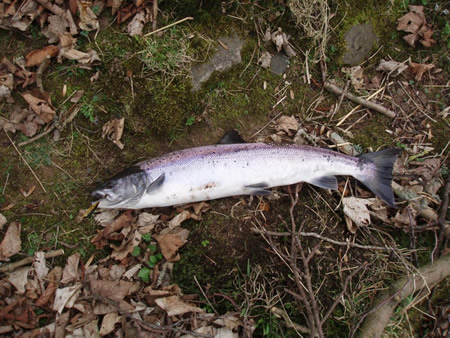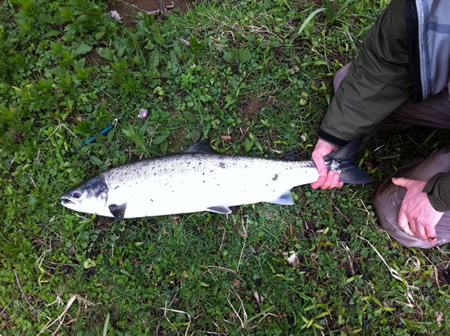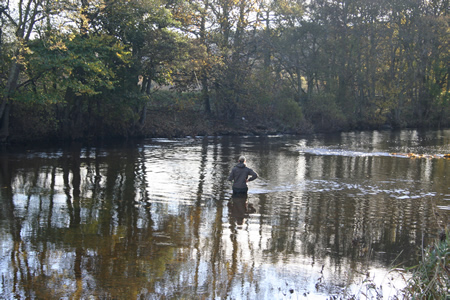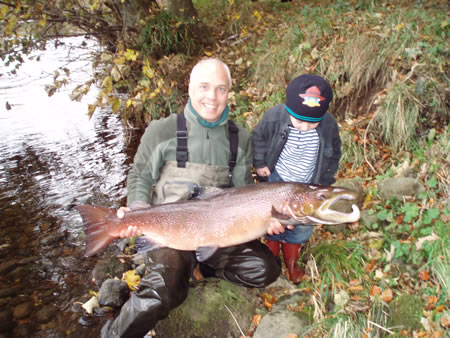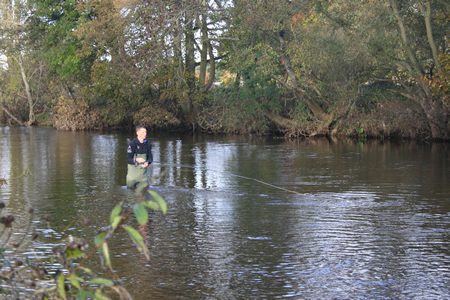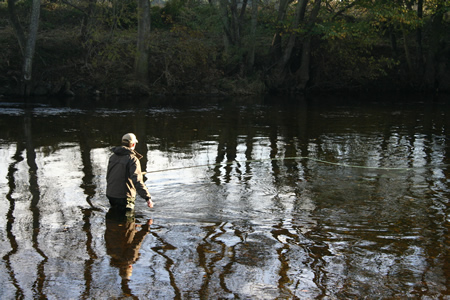These bulletin blogs represent news about Finavon and the South Esk, and my views as a riparian owner. They are not the views of any other organisation, nor are they designed to promote the interests of any individual or organisation other than Finavon Castle Water and factors affecting the fishery. Tony Andrews
February 2012, when the Marine Scotland radio tagging and tracking project began, now seems a long time ago. I know that there are people who question the value of the project on the grounds that the number of fish recorded as having visited or remained in the South Esk is a small sample and represents less than 10% of the total number (153) of spring salmon tagged in the Usan nets between February and May 2012.
Julian Maclean and Gordon Smith of Marine Scotland fixing a receiver’s aerial at Finavon in February 2012
The last published update of distribution of radio tagged salmon in the South Esk catchment is the 31st of October and shows that a total of 16 fish were recorded as having entered the South Esk . I assume this means that the most downstream of static receivers near the Bridge of Dun recorded their arrival in the river – and presumably those that subsequently left the river “returned to sea”.
Of the 16 fish that entered the river, 6 are reported as having “returned to sea”. The remaining 10 fish are distributed within the middle and upper river:
- 5 salmon tagged in May are in the middle and upper catchment, with two in the South Esk above the confluence with the Prosen, one in the Prosen, one close to the confluence with the Quarity Burn and one in the South Esk close to the mouth of the Noran Water.
- 2 salmon tagged in April are in the South Esk, one at the mouth of the Rottal Burn and the other near the A90 bridge at Finavon
- 3 salmon tagged in March are all in the main stem of the South Esk, two in the Justinhaugh/Inshewan area and the third just upstream of Brechin.
As far as the South Esk is concerned, these are the data gathered to date by the project. No fish tagged in February were later recorded.
The 6 salmon that are said to have “returned to sea” should not be ignored because they provide some data on the behaviour of early running (‘Spring’) salmon.
Salmon tagged by the project team and later recorded in the South Esk and in nearby rivers (Dee, North Esk and Tay) totalled 54 and their breakdown is:
Dee 8 salmon, North Esk 19 salmon (of which 6 “returned to sea”), Tay 6 salmon and caught (presumably by Usan’s nets) “at sea” 3.
So, about 30% (54) of the salmon tagged (153) were later recorded, which, in the light of comparable projects, is quite a good return.
Of the 54 salmon recorded, 12 are reported as having “returned to sea” which gives us 42 spring salmon caught and radio-tagged in the Usan nets, attributed to rivers where they will presumably choose to spawn.
When thinking about the results of the first year of this three-year project I feel there may be some uncertainties which should be taken into account:
- The technical reliability of the transmitters or receivers may have been at fault, resulting in nil or false readings
- The possibility that salmon were still feeding in the sea when caught, which might result in their stomachs not having atrophied, and that fish may therefore have regurgitated the transmitters.
- Transmitters may have been regurgitated or ceased functioning for other reasons.
- That fish were predated or poached after being tagged
- That fish travelled further afield to rivers other than the South Esk’s 3 identified neighbouring rivers
- That fish were damaged when the radio transmitters were fitted, and in consequence died.
Is catching these salmon at sea the best way to obtain tracking data?
For example:
- 1. Might it be better to catch the fish in the fresh water of the South Esk, or at the very least in the brackish waters of Montrose Basin?
- 2. I recognise that there may be problems in deploying a net and coble crew in the Basin, or in fishing with nets within the river itself.
- 3. Perhaps, by netting spring salmon within the river, salmon which a) had stopped feeding and b) were likely to be destined for the South Esk would then be caught, thus reducing the ‘by-catch’ of salmon bound for rivers other than the South Esk; just a thought.
While the list above does suggest some possible reasons for a partial failure in achieving a larger sample, the fact is that the numbers of fish recorded do constitute a useful sample. If the next two years of the project build on these numbers we can expect some more useful data to emerge on where the South Esk’s Spring salmon spawn, and where in the catchment their progeny spend their juvenile years.
It will be interesting to read Marine Scotland’s evaluation of the project’s first year and in February how the second year’s catches develop.
TA
